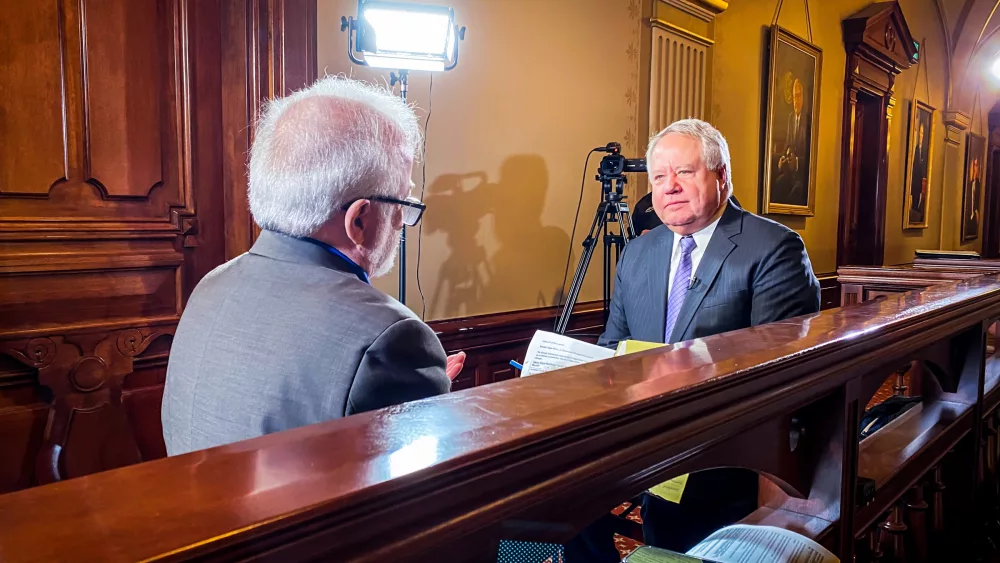North Mansion Block Plaza was sunlit just about ten minutes after noon on Wednesday; it was not terribly warm in Springfield on that day, but not uncomfortably cold either. A group of tourists peaked through the bars of the fence surrounding the Governor’s Mansion as a landscaper went about cutting the grass.

As President John Anderson of the local non-profit Distress Bandanna Teen Driver Safety Initiative rode up on the motorbike that his wife – Treasurer Vivian Anderson – won through WQLZ’s famous Summer Thunder Tour, he asked if we thought anyone would mind if we got some pictures of the bike in front of the mansion itself.
As Vivian parked her car around the block, and John walked the bike over to a good spot, he began to speak. The story – at that point – seemed to unfurl out of the man with a truly intoxicating passion and conviction; the sound of the camera shooting, of cars going gently by down Fifth Street, and of the lawnmower taming the lawn, could do nothing to drown out the message that either John or Vivian wish to spread.
It all began in Sturgis, South Dakota – as so many stories, thoughts, and other things have, and seemingly still do. John Anderson was there with friends on his motorcycle. And, as they were talking about riding and safety and the like, a thought crept back into his mind that he had considered many times prior: what might a better, safer means of alerting fellow drivers around you that you require assistance when pulled over upon the side of the highway be?
The phrase “Distress Bandanna” kept running through his mind all the while; hazards, after all, are not used exclusively to call for help, but to possibly denote numerous different things as well.
To this point, as he and his friend were leaving Sturgis on that day years ago, he noticed more than just a few dozen fellow motorbike riders pulled over on the side – hazards all on – but not all in some or even any distress.
“When I came home that day, Sunday, everybody was in a hurry getting home because they wanted to get back to work, I probably passed up at least 100 motorcycles on that interstate straight East going from Sturgis to Sioux Falls or Sioux City…Well, I stopped for six people, and nobody needed help. So I thought, ‘I’ll never get home if I keep stopping for everybody,’ so I just went home and – you know – I told you, it just kept ringing in my head ‘distress bandanna,’ and the question of what to do with it.
Probably about three weeks later, I found out that I had passed three people that sat there for over eight hours – along the road, I passed right by them – I had no idea…The hazard lights just show that they’re sitting there; you don’t know – it’s just like a car. You don’t know if they need help or not.”
Yet what began as an idea to collectively communicate better, would develop differing appendages soon as well; not only was there no widely known method of alerting fellow drivers and assistance that an individual requires assistance or aid, but there were no documented or taught safety procedures either.
Worse still – as John and Vivian’s research would help them to realize – accidents, injuries, and deaths due to various, assorted, driving-related matters were and remain a terrible problem that affects nearly every person across society to some degree; 2017 would be a landmark year for the Andersons and Distress Bandanna.
When – after John had given us his perspective and recollection of circumstances and events – Vivian noted some particular successes since the non-profit’s 2017 creation, the breadth, impact and scope of their collective ambition and endeavor came into clearer focus.
“Our initiative has presented a grand total of 2,000 high school classroom Teen Driver Safety presentations, impacting 75,000 teen drivers across both Illinois and Indiana. Our focus is on distracted driving, drowsy driving, the Move Over Law, Scott’s Law, stranded motorists’ safety tips, medical emergencies, the proper way to wear a seatbelt, and downed power line vehicle safety. We promote teen driver safety and education from pre-permit to post-license through education, training, and resources that are supplemental and additive to traditional drivers training or mandated state driver’s programs.”
She then began speaking on some of the subjects that she remains as focused on today as she states she was at the very start of things all those years ago. Regarding distracted driving – April is Distracted Driving Awareness Month – teen driver safety, teen motorcycle safety, as well as the construction and dissemination of rules and guidelines to follow when a person finds themselves pulled over upon the side of the road, a glimmer does flit across Vivian’s eyes as her voice grows stronger and more forceful – still kind, but now invigorated.
“In 2019, according to the US Department of Transportation, there were 2,042 people killed in crashes involving a teen driver – 15-18 years old – of which 628 deaths were the teen driver, and 45% of the teen drivers who died were unbuckled. Understanding that teen drivers ages 16 and 17 are three times as likely as adults to be involved in a deadly crash – according to the AAA Foundation for Traffic Safety – as we do, our program reaches out to young drivers in a supplementary manner across high school drivers’ education classes. According to the 2021 Illinois Crash Facts & Statistics, curated by the Illinois Department of Transportation, teenagers – ages 16 through 19 – account for 8.4% of the total A-Injuries and 7% of the total fatalities. The total number of teen fatalities was 94, and the total number of teen A-Injuries was 789 in 2021.
So we go into the driver’s education classes, and we actually talk about – amongst other things -what the protocol is and must be for you as a driver, as well as if you do become stranded along the roadside…For example, you pull over and move out of traffic as much as possible. You do not flag down other vehicles, you do not stand next to your vehicle – instead, you try to stay in your car. You only exit your car if it is completely necessary and safe to do so. If you do exit your vehicle, you exit from the opposite side of oncoming traffic. You always want to try to stay safe and sound, on the sidewalk, behind a guardrail, or maybe on the edge of a field. Then, of course, you keep your eyes on traffic if you stay in your vehicle. As a stranded motorist, you keep your seatbelt on. To always remember that the fatal zone is right around your vehicle is also very important.
The fact of the matter is simply that at some time across life, everyone will become stranded along the roadsides. Whether it’s changing your tire, it could be because of a medical emergency, perhaps because of bad winter weather – black ice, for example.
Or it could be something as common as having engine problems or suffering from a flat tire along the roadside; no one can ever know what’s going to happen for sure. We ultimately decided to incorporate downed power line vehicle safety into our safe driving program to educate, protect, and keep our communities safer based on this thinking too. We always say, just remember that it’s becoming increasingly more dangerous to be stranded or parked along the roadsides now – no matter what the reason is. Why? Well, in part because of all the distracted drivers out there now veering off the roadsides and hitting those that are stranded…
…between 2019 and 2021, there were 456 documented motor vehicle crashes occurring on Illinois Public Roadways involving a disabled vehicle; of those documented cases – admittedly an incomplete number, as statistics of this nature are calculated using remarkably arbitrary qualifications – 35 individuals needlessly died as a result of a combination of distracted driving and a lack of comprehensive procedures for just such a predicament as being pulled upon the side of the roadway or highway.”
For Vivian and John, they recognize that it’s been a long road from Sturgis – from the start of their journey to today – and that there remains a way yet to go; further innovations are seemingly on the horizon, though.
This coming week – nearly six years after the task of making life safer for human beings earnestly began, and even longer since John Anderson made that fateful trip back from South Dakota to Sangamon County – the Illinois House of Representatives of the General Assembly will hear just precisely why the collective state legislative body should pass a public safety and education bill backed and fought for by the Distress Bandanna Teen Driver Safety Initiative which unanimously – and in bipartisan fashion – sailed through the Illinois State Senate just weeks ago.

The Senate sponsors – Laura M Murphy, Springfield’s own Steve McClure, Julie A Morrison, and Andrew S Chesney – will be hopeful that their legislative ally for this endeavor in the house – Representative Katie Stuart – can raise support where necessary. Distress Bandanna will be at the Illinois Capital this very Wednesday to do its part to ensure that progress does indeed continue onward.
Furthermore, a special guest will be one of Distress Bandanna’s two Teen Driver Safety Ambassadors, will be speaking on behalf of the initiative and in support of the support of Senate Bill 2028 in the Illinois House of Representatives.
But what – across all of these driver safety-related topics – is the thread that runs through all of that which the Distress Bandanna Teen Safety Initiative works for across their areas of focus? Well, both Vivian and John mentioned the word “humanity” throughout our conversation in the sunshine, but what John noted just as we were getting ready to part ways struck a particular chord with WMAY that day, and indeed answers the aforementioned quandary.
Our thanks to President and Treasurer Anderson and Anderson for their individual and collective time and compassion.“We tell the students all the time, I don’t care where you’re at; in your car, at your home, in the woods, at or in the water – it doesn’t matter. If you need help, let that be known somehow, get it out there, so that people can see it immediately. And that’s the whole goal, no matter where you’re at; if you need help, don’t be scared to admit it and ask for it.”





